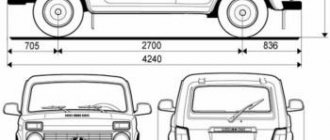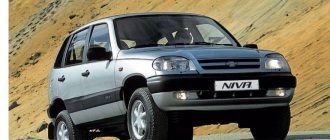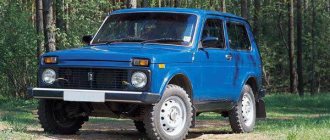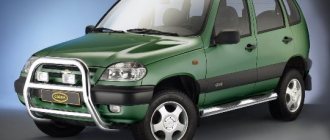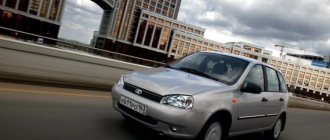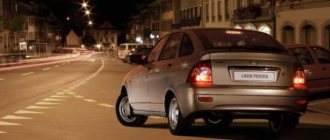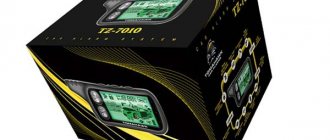Production history
Serial production of the VAZ Niva 21213 began in 1977.
The most eminent design engineers of the USSR were involved in the development of this SUV. Probably, it was the unity of all the actions of the design bureau workers that made it possible to create a car characterized by high cross-country ability, light weight and unpretentious maintenance. VAZ Niva 21213 is the first car in the history of the domestic automotive industry that was created specifically for off-road driving, traveling to the most inaccessible places, as well as for fishing and hunting trips. All this was facilitated not only by all-wheel drive and a powerful gasoline engine for those times, but also by a practical body layout - a folding rear seat made it possible to place various household goods weighing up to several hundred kilograms inside the Niva.
VAZ-21214 engine modifications
| 21214-41 | modification with a power steering pump, with a welded steel manifold, YAZTA hydraulic supports, Euro 3. |
| 21214-34 | modification without power steering pump, with cast iron manifold, INA hydraulic mounts, Euro 3. |
| 21214-33 | modification with power steering pump, cast iron manifold, INA hydraulic mounts, Euro 3. |
| 21214-32 | modification with power steering pump, cast iron manifold, INA hydraulic mounts, fuel pipes for quick connectors, flywheel for clutch 215mm, Euro 3. |
| 21214-31 | modification with power steering pump, steel welded manifold, INA hydraulic supports, Euro 4. |
| 21214-30 | modification without power steering pump, with welded steel manifold, INA hydraulic supports, Euro 4. |
Photo of the VAZ-2121 engine
Domestic Range Rover?
What unites the domestic VAZ 2121 with the British Rover? At first glance, absolutely nothing. However, you just have to take a closer look at the technical part, and everything will become clear. The fact is that the Niva used a non-disconnectable drive on all four wheels with a transfer case and a locking center differential. This is exactly what the British Range Rover had in the 70s. Thanks to such equipment, the domestic SUV could easily overcome fords, ravines and other off-road conditions. At that time, the new Soviet jeep had no analogues in terms of cross-country ability and comfort.
Tuning VAZ-2121 Niva (40 photos)
Tuning the VAZ-2121 Niva car, several options for tuning a domestic SUV.
VAZ-2121 “Niva” is one of the most popular budget SUVs of domestic production in our country. The car has a 4 x 4 wheel arrangement and good off-road performance.
We offer you to look at several examples of original tuning of the VAZ-2121 Niva.
Popular homemade products from this section
Share on social media networks
avto-samodelki.ru
Equipment and comfort
At first glance, the VAZ Niva 21213 is the Volga analogue of the Ural UAZ 469 model. Yes, in terms of driving performance and cross-country ability they are almost Siamese twins, but inside they are completely different. The front row of seats has headrests, the backrest is adjustable in length and angle, the rear row folds to increase luggage space. Upon request, the Niva was equipped with a rear window washer and cleaner, as well as an electric window heater. By today's standards, the equipment of the Volga SUV is almost ascetic, but in the 70s they did not even dream of such luxurious things.
History of the machine
It all started back in 1970, when Chairman of the Council of Ministers of the USSR Alexei Kosygin, as part of the program “blurring the line between city and countryside,” set the teams of VAZ, AZLK and Izhmash the task of creating a comfortable SUV for residents of rural areas.
The first experimental VAZ-E2121 saw the light of day in 1971. Moreover, his appearance was very far from what we have become accustomed to for forty years. In fact, it was a chassis with a simple tail, on which the concept of a new car was developed - the SUV did not have a frame, which at that time was considered an unheard-of design audacity. Initially, the car was planned to be equipped with a powerful diesel engine, final drives, rear torsion bar suspension and even a tire pressure regulation system, but later they decided to create a simpler version with a high degree of unification with the models already produced by AvtoVAZ, which was economically justified. This prototype allowed the design bureau under the leadership of Peter Prusov to significantly reduce the time needed to create the car.
The VAZ-2121 appeared in a form close to the serial one in 1972. The artist Valery Semushkin worked on the design of the new car. The car, according to the designer, was supposed to suit residents of both cities and villages.
In 1974, the car was put up for state tests and in the same year received its own name “Niva”, which was patented.
In addition to sales at home, Niva was actively promoted in foreign markets. Over forty years, more than 500 thousand SUVs were sent abroad. This unpretentious, but at the same time quite comfortable SUV has attracted buyers in more than 100 countries around the world. Importers actively re-equipped the car, making it into pickup trucks, convertibles, and styling it according to fashion. In addition, assembly of the model was established in Brazil, Greece, Canada, Panama, Chile, and Ecuador.
In 1978, the VAZ-2121 was awarded a gold medal and recognized as the best car of its class at the international exhibition in Brno. “Niva” has a lot of records.
So, in 1998, Niva climbed Mount Everest under its own power, to a height of 5200 meters, in the same year, being dropped by parachute, it ended up in the Arctic and reached the North Pole under its own power, and the next year climbed to the Himalayas to a height of 7260 meters. She also visited Fuji. The reliability of the car is also evidenced by the fact that the production car was able to operate without serious breakdowns for 15 years in Antarctica at the Bellingshausen station.
In 2001, the history of the VAZ-2121 as a Niva ended. The holder of the exclusive license for the Niva trademark was the GM-AvtoVAZ joint venture. But the history of the car itself continued and continues under the name LADA 4X4.
VAZ Niva 21213: technical specifications
Initially, the car was equipped with a 4-cylinder carburetor engine with a volume of 1.6 liters. Next came new modifications, as a result of which a 1.3-liter engine was added to the line of power plants, but it was not particularly popular among car enthusiasts.
As for the gearbox, the Niva was equipped with a four-speed manual gearbox with synchronizers in the forward gear. A little later, the SUV began to be equipped with a more advanced transmission - 5 steps. Don’t forget about the transfer case, which allowed the SUV to overcome any off-road conditions. The two-stage transfer case with center differential had a forced lock. The cardan transmission consisted of cardan shafts of the rear and front axles, as well as an intermediate shaft.
The suspension also had its own technical features. The front was independent, on wishbones with hydraulic shock absorbers, springs and a stabilizer bar, which prevented the car from tipping over when cornering. The rear suspension is dependent, with coil springs, one transverse rod and four longitudinal ones. Like the front one, it was equipped with several hydraulic shock absorbers.
Modifications of the VAZ 2121 Niva — SovietCars.net
During the production process, the Niva was modernized, and various cars were manufactured on its basis.
The Niva has been produced since April 5, 1977 to the present time under the name Lada 4x4.
VAZ-E2122 amphibian
Even before the start of serial production in 1976, a prototype VAZ-E2122 amphibian was built on the basis of the Niva.
VAZ 2121 Niva
The base model was equipped with a 1.6 liter, 80 hp engine. With.
VAZ-21211
1978 - 1987
It was equipped with a modified VAZ-21011 1.3 l, 69 l engine. With.
The car was manufactured for export to countries with high taxes. First of all, these are the countries of Benelux and Southern Europe. The low-power engine had poor dynamics and torque, so the VAZ 21211 did not gain much popularity and widespread use.
VAZ-21212
Modification for export, with right-hand drive. Designed for countries with left-hand traffic, supplied to New Zealand, Australia, Japan. In the UK the car was sold under the Cossack brand.
It is also known that in addition to assembled cars, some countries were supplied with vehicle kits for on-site assembly. This is confirmed in order No. 19 of January 28, 1981 by the General Director of the AvtoVAZ association A.A. Zhitkov “On preparation of production and supply of disassembled VAZ-21212 cars.”
VAZ - 21213 "Taiga"
In 1989, work began on modernizing the field.
Since 1991, the plant began producing the transitional model VAZ-21219, which was equipped with an engine and chassis from the VAZ-21213, and the body and interior corresponded to the 2121 model.
Production of 21213 began only in January 1994.
Distinctive features of the new model:
- New engine;
- Other rear optics;
- New rear door;
- The interior has changed;
The 21213 was equipped with a 1.7 liter engine, 81.8 hp, torque 125 N•m. Solex carburetor and contactless ignition system.
It was assumed that the front part of the body of the new model would also change, in particular, the dimensions and turn signals should have been located on the sides, next to the headlights, but for certain reasons the alteration did not take place.
The name “Taiga” assigned to the car did not take root within the country; it was later used as a designation in some markets abroad.
VAZ – 21214 (Lada 4×4)
Modification of model 21213. Produced since 2000 for export and since 2002 for the domestic market.
A distinctive feature is the engine with central fuel injection.
Modification of the VAZ-21214-20 with an electronic engine control system, the system was manufactured in Russia.
Modification 212146 – for countries with left-hand traffic, right-hand drive.
VAZ – 21215
Cars with diesel engine. For the first time, the task of developing a diesel Niva was set by the USSR Minister of Automotive Industry V.N. Polyakov in 1979.
VAZ 21216
The modification corresponds to model 21213, but with right-hand drive.
VAZ 21217
The modification corresponds to 21213, and the engine of modification 21211 is low-power - 21011. Manufactured for export.
VAZ-21219
Transitional model with body 2121, and engine and interior from 21213.
VAZ-2121B
1992-1993 Limited edition.
Armored modification. Developed by the scientific and technical center of the AvtoVAZ concern together with the commercial bank for social development Lada-Bank.
Designed for transportation of valuable goods, a collection vehicle.
The result of the firing test confirmed that the interior was protected from the impact of a steel bullet from a 7.62 mm Kalashnikov assault rifle, and the bottom from grenade fragments.
For the first time, foamed polymers were tested for anti-fragmentation armor.
The engine compartment is equipped with a fire extinguishing system.
This car became the beginning of the BRONTO Force family of armored vehicles.
VAZ-2121F
The commercial version with a van-type body was manufactured on the basis of the VAZ-2121 and 21213 models.
The modification differed in that the rear side windows were replaced with metal panels, and the rear seat was missing. There is a metal panel and tubular protection behind the front seats to prevent cargo from shifting while driving.
It is known that the 2121F was manufactured in small batches at the AvtoVAZ production plant and was supplied only for export to non-CIS countries, where local legislation provided for tax incentives for such commercial vehicles.
In addition, some foreign dealers made their own vans. The applicability of the model name 2121F to them is questionable.
For example, the Czech company CS AUTO LADA produced vans called Niva Praktik.
Moreover, the company produced a modification of the Niva Praktik Special with a rear overhang increased by 365 mm and a reinforced plastic insert in the roof. Rear shock absorbers and springs are reinforced.
VAZ-212180 “Fora”
1996—2011
A version of model 21213 extended by 300 mm. It is distinguished by enlarged door openings and a raised rear part of the roof, which is made of durable plastic. Rear sofa type 2108, three-seater.
Produced.
As standard, it was equipped with a fire extinguishing system in the engine compartment, like in the Force armored vehicle.
The following options were installed:
- Power steering
- Air conditioner
- Plastic "kenguryatnik"
It is interesting that due to the fact that the Fora was equipped with wheels of increased diameter (the wheels were manufactured and the tires were Nokian HRC), the spare wheel did not fit in the standard place under the hood, so it was installed on a special mount on the rear door.
VAZ-212182 “Force”
Armored car based on 21218.
Standard equipped with:
- Automatic fire extinguishing system under the hood;
- Explosion and fireproof gas tank;
- Additional battery;
- Remote lock of the right door with a button for the driver;
- Air conditioning;
- Reinforced suspension because Due to the armor, the car became 430 kg heavier. Springs with increased coil thickness and reinforced shock absorbers were installed.
As additional equipment, the vehicle could be equipped with an armored bottom, beacons, etc.
VAZ-212183 "Landole"
1997—2009
Produced only to order based on model 21218.
A distinctive feature is an open body without doors and the rear part of the roof, the tailgate is hinged.
To strengthen the body, a pipe frame is provided.
The standard package includes:
- Front and rear seats of the VAZ-2108 with removable covers;
- Full set of seat belts;
- Heater;
- Mounted plastic covers on the body;
- Spare wheel mounting bracket on the rear side;
As options:
- Cast aluminum alloy wheels;
- Grille-bumper on the front bumper;
- Power steering;
- Electrically adjustable exterior mirrors.
Cars with 1.7 and 1.8 liter carburetor engines were produced.
VAZ-2129 “Cedar”
1992-1994
A version of the Niva extended by 500 mm, built on the basis of 21213. The body was lengthened due to the central insert, and another side window appeared.
Initially it was conceived as a carrier of units for the promising minivan VAZ-2120, but was produced in small quantities. Subsequently, the model served as the basis for the creation of the five-door Niva 2131.
VAZ 2129 “Utiliter”
The commercial modification of the "Cedar" featured barred rear side windows and no rear seat.
The car was manufactured to order at OPP AvtoVAZ.
VAZ-2130 “Cedar”
1993-1994
modification of the VAZ-2129 with a modified interior layout. The three-seater rear seat of type 2108 is moved forward. According to unverified information, the model index was subsequently changed to 2129-01. Served as the basis for the creation of the five-door model 2131.
VAZ-2131 (Lada 4×4 5-door)
1995 - to present time.
Five-door version of the Niva, extended by 500 mm. Created on the basis of 2129 and units 21213, 21214.
It was popularly nicknamed “crocodile”, “sausage”, etc. because of his awkward appearance.
VAZ-2131 SP
Ambulance. The base increased by 300 mm due to the rear overhang and the high roof made it possible to transport a patient on a stretcher and two doctors with equipment.
Subsequently, modifications with the designations 2131-05 and 2131-45 were produced with minor changes.
2131 SP 2131-45
VAZ-2131-02
Like the 2131 model, it was distinguished by a high roof and an increased rear overhang, but it was a civilian vehicle, not an ambulance. There were 2 additional seats in the trunk, thus providing 7 seats.
Subsequently, modifications with the designations 2131-22 and 2131-42 were produced with minor changes.
VAZ-2121 sugar-1
The first extended version, created in 1991 as a prototype by enthusiastic designers at the VAZ plant.
A total of 6 cars were produced. Some of the cars were registered as homemade by private individuals, the rest were bought by Lada Bank, and were registered under their own name “Sahara” and were used for official purposes.
Subsequently, using developments on this machine, other extended versions were created, such as 2129 “Kedr” and 21218 “Bronto”.
VAZ-2328
An experimental pickup truck with a double cab built on the basis of model 2131. It is known that cars were assembled with short and long overhangs.
It was supposed to launch production in parallel with model 2329, but it was possible to produce only an installation batch because there wasn't much demand.
You can find mentions that the name of the model is “Wolf”, but the model did not receive an official name, just at one of the exhibitions a wolf was depicted on only one car.
VAZ-2329, Niva Pickup, LADA 4×4 Pickup
A pickup truck with a five-seater cab built on the basis of model 2131. The rear overhang has been increased by 300 mm. The rear seat folds down to create a flat cargo area.
Load capacity was 650 kg.
There are two configurations:
VAZ-2329-01 basic
VAZ-2329-04 basic, equipped with an awning for the cargo area.
As options:
- plastic superstructure for the cargo area;
- additional front guards;
- safety linings on the sides;
- rear window protection;
- fog lights;
- air conditioner;
- and etc.
Also on order, instead of the 21213 engine, a 2130 engine with a volume of 1.8 liters and a power of 84 hp was installed. With.
You can find mentions that the name of the model is “Bear”. According to one version, the first cars had their own name, according to another version, model 2329 did not have its own name.
It was produced at OOP AvtoVAZ, and then production was transferred to a subsidiary.
BRONTO-1922 “March-1”
snow and swamp-going vehicle (“pneumatic”) on ultra-low pressure wheels on VAZ-21213 units. It has been produced in small batches by PSA BRONTO OJSC since 1997.
FVK-2302 "Bison"
A pickup truck with a frame chassis, a double cab and a wooden platform, created on the basis of Niva units.
It was produced in small batches by Togliatti in 1993-1995. The Bison's reinforced rear suspension was leaf spring.
The pickup truck was not in demand and did not receive mass distribution.
sovietcars.net
The first modernization of a domestic SUV
Oddly enough, the first modernized Niva model went into mass production only 16 years later. Moreover, practically nothing has changed in the technical part of the car - all the parts and assemblies are from 1977! The exception was the new internal combustion engine, but more on that a little later.
The main changes affected only the external appearance of the Niva. The new modification is distinguished by a more elongated body and slightly modified brake lights at the rear. By the way, the trunk lid could now only be opened from the passenger compartment. The bumper remains metal, but is now painted light gray. In general, the exterior of the car is not particularly sophisticated or cool. However, today's off-road tuning of the VAZ 21213 (Niva), which consists of installing power bumpers, snorkels, new wheels and other units, can significantly modernize the appearance of the car.
Inside, the changes were also minimal - the seats and instrument panel became similar to Ladovian ones (from the VAZ 2108). What do the owners say? According to reviews, the Niva 21213 became more comfortable after modernization, but the designers still could not avoid the old shortcomings (distortions of the back and constant noise inside).
And now about the technical part. Since the beginning of 1993, the modernized version of the Niva has been equipped with a new gasoline engine with an increased displacement - up to 1.7 liters. For the first time, a contactless ignition system was used on an SUV. The carburetor was also changed. The braking system has been improved. The main gear of the gearbox now has a gear ratio of 3.9. The muffler has also undergone minor changes. Now its body is not welded, as before, but rolled (like the Lada of the eighth model).
As practice shows, new improvements in the internal combustion engine and transmission system have made it possible to significantly reduce fuel consumption on the VAZ Niva 21213 SUV. So, per “hundred” the car spends about 13 liters in the city and up to 11 liters on the highway.
Export versions of the Niva had central fuel injection and were equipped with a non-disconnectable wheel drive with a center differential and a transfer case with a reduction row. At the request of the customer, the car could be equipped with a French diesel engine from Peugeot with a displacement of 1.9 liters. But, unfortunately, these were only isolated cases.
technical specifications, reviews and tuning
domestic jeep
For a long time, the Niva car was produced in the same version with virtually no changes. In 1989-1990, the manufacturer made a decision and began developing an updated version of the SUV. Since 1994, serial production of the car has been launched under the factory name VAZ 21213 and the consumer name Niva Taiga. The technical characteristics of the machine have been significantly improved. The new model is equipped with a more torquey engine with a power of 78.9 hp, a displacement of 1.7 liters and a torque of 127 Nm. The changes also affected the appearance of the car: the loading height has been reduced, which is now almost equal to the height of the rear bumper, and the shape of the rear door and lights have been changed.
The Niva SUV is in consistently high demand among foreign buyers. In foreign markets the car is known as Lada 4x4. The model is exported mainly to automotive markets:
- Canada
- Germany.
At the height of the crisis, interest in inexpensive Lada 4x4 SUVs increased on the part of European consumers. The new Niva 2014, 2015 model year developed by AvtoVAZ will presumably go mainly to the German market. From the standard version, the new Taiga 2014, 2015 release is distinguished by the presence of an anti-lock braking system, an electronic gas pedal, and a power steering wheel. The bottom of the car will be protected by a steel sheet.
Return to contents
A universal vehicle for city and off-road use
Updated car
The Niva's all-wheel drive system not only provides high off-road capability, but also increases active safety when driving on asphalt. For urban conditions, this is a fairly maneuverable car. The engine power is quite enough to accelerate vigorously and fit into the traffic. The short length of the car, only 3.7 meters, makes it easy to park even in limited spaces.
The driver will be able to appreciate the main advantages of the VAZ 21213 only when the asphalt runs out and off-road starts. Niva is an SUV that can drive over almost any terrain:
- Forest,
- field,
- Country road washed out by rain.
Taiga overcomes any obstacles, it’s just a matter of the driver’s courage. The high cross-country ability of the VAZ 21213 has been tested in extreme Russian off-road conditions.
Operating cost is one of the important factors that you should pay attention to when choosing a car. Spare parts for the Niva are always available in any car store, their prices are inexpensive, so repair service will not cause problems for the owners. Some discomfort on long trips can be caused by not very good sound insulation.
By making internal tuning of the VAZ 21213 interior, you can correct this annoying issue. It is with the soundproofing of the interior and engine compartment that competent Taiga tuning begins.
Return to contents
Reviews of VAZ 21213 and its modifications
VAZ 21213 and its modifications are all-terrain vehicles. The car body is load-bearing, all-metal. All wheels are constantly driven, there is a center differential locking mode. Engine - four-cylinder, in-line, four-stroke, gasoline. It must be said that diesel is practically never found in Russia. Only the exported VAZ 21215 is equipped with a diesel engine with a displacement of 1.9 liters. A carburetor engine with a displacement of 1.7 liters is installed on the VAZ-21213; an engine of the same volume, but with distributed fuel injection, is installed on the VAZ-21214. VAZ 21214 cars are equipped with a toxicity reduction system with a three-component neutralizer.
Special modifications based on the classic Niva, for example, VAZ 2329, or “Bear,” are also produced in small series. VAZ 2329 is a pickup truck with a double cab. Both “Bear” and “Taiga” have engines of equal volume, but with different power systems. Analyzing their technical characteristics, we can conclude that the injection engine (82 hp) installed on a pickup truck is not much more powerful than the carburetor engine on a classic car (79 hp).
Special edition of the car
By comparing the VAZ 2329 and VAZ 21214, we will try to determine which of the cars is more suitable, for example, for fishing or hunting. Both cars are five-seater. In the Taiga, the front seats move forward and it is quite easy for rear passengers to enter the cabin. In the "Bear" it is much more difficult to get into the back row of seats, since the backs of the front ones recline, but do not move back. The trunk of the Lada Taiga is small; a large hunting trophy may not fit in it. But if you fold the back row of seats, the luggage compartment is almost equal in size to the Bear’s cargo compartment. But at the same time the car will turn into a two-seater.
The large rear window of the VAZ 21213 provides good visibility to the rear, while the VAZ 2329, on the contrary, has limited visibility. Both cars have approximately the same cross-country ability on dirt roads and forest roads. High ground clearance (220 mm) and 16-inch wheels allow them to get out of all traps. However, after comparing the technical characteristics of the VAZ 2329 and VAZ 21214, we can conclude that the VAZ 21213 is still more suitable for driving through fields, forests and ravines. Thanks to short overhangs and a small base, it is less likely to catch the ground in areas with difficult terrain.
An inexpensive and good SUV is the dream of every man who loves hunting or fishing. Today, perhaps, only Niva meets these requirements. The car does not look “old” even compared to modern jeeps with their sophisticated electronic systems. And on the off-road, the Niva will also give many a head start. Where no car can pass, the Niva will crawl.
In addition to increased cross-country ability and reserve energy capacity of the suspension, another serious advantage of the Niva is the presence of a low gear and a locking center differential.
expertvaz.ru
Lada 21213: owner reviews
Judging by numerous reviews, the VAZ 21213 has many advantages, including:
- Good maneuverability
- Cheap to operate.
- Reasonable fuel consumption
- Four-wheel drive
- Low price
- Reliability
- Simplicity
- Multifunctionality
- Comfortable and powerful SUV
- Spacious trunk
- Comfort
- Ease of control
There are also disadvantages:
- No air conditioning
- Frequent vibrations in the cabin
- Shaking
- weak engine
- High fuel consumption
- Expensive spare parts
Deutsche Lada Niva Cabrio
German masters were interested in changing the Soviet Niva. So in 1983, based on this SUV, Deutsche Lada Automobil GmbH, which was the official importer of these cars, introduced a convertible, which completely lacked side pillars and roof strength elements. But a tubular frame appeared, with which they decided to strengthen the body.
The new version has front seats with head restraints, enhanced lateral seat support and seat belts. Additionally, plastic fender extensions were used, which were painted in the color of the car and gave it a more impressive look.
Bronto-1922-55 "Marsh-Combi"
This is a newly modified Niva car, which was transformed by specialists from Bronto. The basis of the transport was the bridges and frame of the UAZ-3151, but the body was used from the VAZ-21213. The first thing that catches your eye is the huge pneumatic wheels, which allow this vehicle to move on low-traffic soils, which is where the name “March” comes from, meaning “swamp” in French. The gearbox, engine and transfer case still remain from the Niva in this seriously updated SUV.
Bronto-212183 "Landole"
This model was also presented. The classic Niva has been greatly modified. The upper part of the body was completely removed and a safety cage was installed in its place. The doors were completely removed, and small plastic stops appeared instead. The usual trunk is also missing here, which has been replaced by an open side. This model was produced in 1998-2009.
Bronto-212182 "Force"
Niva cars are often used as a basis for creating unusual modifications. One of the interesting solutions is an armored vehicle, called “Force”, in which the armor and glass are capable of withstanding a 5.45 mm Kalashnikov burst. and 7.62 mm. This model was developed for collectors. Additionally, it was equipped with an air conditioner, another battery, and a fire and explosion-proof fuel tank.
Lada Niva iKRA
In most cases, visible changes are made during modification. This was the case with an SUV called Lada Niva iKRA. These cars were produced for a short time from 1993 to 1995, and they were supplied to the Spanish automobile market. To attract foreign buyers, it was decided to make the car’s interior more comfortable and use a bright body kit.
VAZ-21213 “Laura”
NIVA Laura is an armored car with hinged doors, based on hidden armor technology. The car was intended mainly for collectors, but could also be used for other purposes. Full-length curved glass provided the crew with a high degree of visibility, and hinged doors made it possible to quickly load or unload crew and valuables.
Lada Niva Special
This is a modification of a classic SUV, created by the Czech company Autolada CZ. The cars were modified in Prague in very small batches. The masters modified the classic version by extending the rear protrusion and installing wings. You could buy such a car in the Czech Republic and Slovakia. Interestingly, the buyer could choose a cargo version called Praktik, which had only two seats and a simple passenger version.

